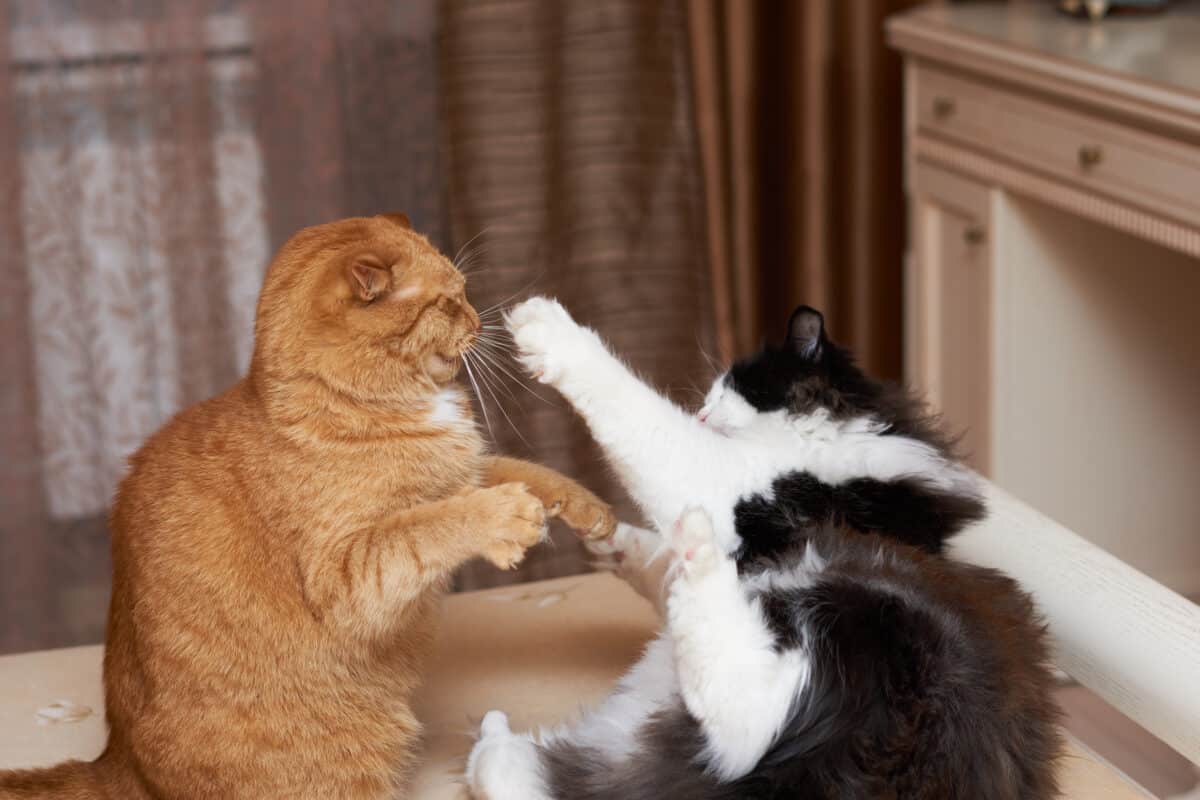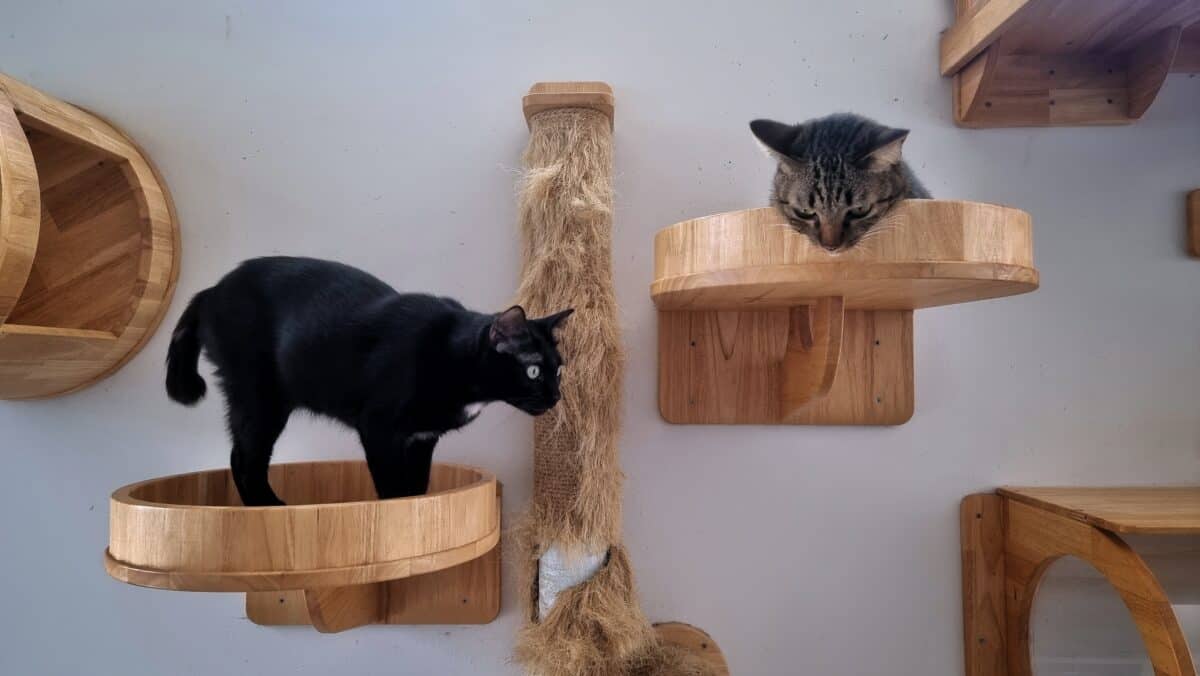Dealing with an unsuccessful cat introduction can be daunting and leave you feeling helpless. It's a common issue when merging two adult cats' lives without proper research or rushing the process.
Did you just place the felines together in one room, crossing your fingers for a positive outcome?
If you're now facing the aftermath of an improper introduction, this comprehensive guide is here to help, offering insightful tips and tricks to rectify the situation.
Why introductions are imperative
Cats are territorial animals. Even neutered cats - both male and female - are likely to experience a great amount of stress when confronted with a strange feline in their territory.
A strange cat is a potential threat, and their instinct is to either run away or try and scare away the intruder. It's a classic "fight or flight" scenario.
If you adopt a new cat and simply bring her home and place her in front of your resident cat, you're basically creating a home invasion.
Imagine how you would feel if you waltzed into the living room to find an entirely strange person just standing there.
What happens when a feline invades another's territory
Here's what happens in the wild when a feline invades another's territory.
Once they make visual contact, the two cats will stare at each other and make threatening noises. They will adopt a threatening body posture to try and seem larger and scarier.
Eventually, one may decide the other is too big and strong to try and take on. If that happens, that cat will try to back away and flee the area.
Sometimes neither cat will run away, in which case a vicious fight will ensue, often for life or death.
Back to our kitties...

Since both cats are confined to your home, the newcomer can't really leave the area. This is a recipe for mayhem.
If you're very lucky, the cats may be too scared to actually attack one another, but even so, you have set the stage for a territorial feud that is likely to deteriorate into violent clashes whenever the cats get too close.
The stress and danger of territorial feuds
While eventually, some cats learn to tolerate each other's presence, the process is very stressful to all concerned.
It can also be dangerous.
Scared cats will fight tooth and claw to protect themselves and their territory. They can seriously hurt each other (and you, should you try to break up the fight with your bare hands).
We hope you're convinced by now that the correct way to get two cats to live peacefully under the same roof must be quite different. Some form of introduction process is necessary.
The older the cat, the longer and more elaborate the process.
How do you even introduce cats?
The key to introducing cats is to go slow and expose the cats to each other's presence very gradually, using one sense at a time.
There are many techniques you could use to implement this strategy, but the principles are the same:
- Begin with the cats entirely separate.
- Gradually expose each cat to the other cat's scent, sound, and sight. One sense at a time.
- Try to get each cat to associate the other cat's presence with something positive.
- Avoid creating negative associations in these situations.
If you're reading this article and need to introduce - or possibly re-introduce - cats, please take a minute to read our full guide on how to successfully introduce cats.
It has a full step-by-step plan for making the introductions the right way.
Why you can't rush cat introductions
The gradual introduction is intended to change the cat's natural behavior, help her tolerate the new arrival, and possibly even make a new friend.
Patience is perhaps the most important ingredient whenever we try to modify feline behavior.
Trying to change feline habits depends on a slow neurological process in the brain: disconnecting certain neurons and connecting others so that the newcomer is finally labeled as a "friend" rather than a "foe".
Cats are creatures of habit, so changing the connections in the feline brain can take a long while.
You cannot rush the process by skipping stages or moving from one stage to the next before the cats are ready.
Put the cats together in the same room too soon, and you could soon be seeing fur flying. You have no choice but to work with both cats in a gradual manner.
How long does it take to fully introduce cats?
There is no single answer that covers all scenarios. As a rule of thumb, kittens are easier to introduce than adult cats - the younger the kitten, the faster the process.
With cats older than 2-3 months, it can take a few days to several months before you can safely allow the cats to share your home without supervision.
In the end, it's also a question of the cats' temperaments. Even the most disciplined introduction process will only take you so far if the cats are naturally shy or aggressive.
So how long does it take?
Here's a picture shared by our member @5starcathotel showing the moment when her 11-year-old cat Hobo finally shared a bed with another cat. It's taken the cats a total of 14 months to get to that point in the process.

SIGN UP FOR THECATSITE'S EMAIL UPDATES >
Do you even have a problem on your hands?
Cat owners often bring a second cat home, hoping to make life more interesting for their first feline friend.
Carefully following the recommended steps of introduction, they finally have the two cats safely sharing the home with no catfights.
The problem is the cats don't seem to like each other. They don't groom each other, play together or sleep cuddled up with one another. What went wrong?
Probably nothing. Even with the best of introductions, it's entirely possible the cats may never become best friends. And that's just fine.
If you expected them to when you adopted the second cat, the problem was with your expectations - not with the cats.
Think of it like this. Let's say you've been living on your own in your apartment for several years. Suddenly, you are forced into taking in a new roommate.
You've been properly introduced - no invasion - just a roommate sharing your living room, kitchen, and bathroom.
Sure, there's a chance the new person may become your new best friend. It doesn't always happen, though.
You'll probably be relieved to just have a peaceful co-existence where everyone follows the rules and keeps a respectful distance from one another. It's the same with cats - so set your expectations accordingly.
Still wondering about getting a second cat? Read this first - Your Second Cat: How To Choose The Best Friend For Kitty
But why are the cats fighting?
We often see questions from new members in the cat behavior forum about recently introduced cats. A common question is: Are the cats fighting?
It can sometimes be hard to tell if the cats are playing aggressively - as kittens often do - or whether they are actually fighting.
To complicate things even further, it's possible for one cat to initiate play-fighting only to have the other respond with genuine aggression.
If you suspect the cats may actually be fighting, look for telltale signs of fear-induced aggression:
- Flattened ears
- Hissing
- Dilated pupils
- Loud howling
When rough playing is one-sided, and the other cat feels under attack, he or she is also likely to actively avoid contact with the perceived attacker.
Observe the interaction between the cats and see if you can find a pattern.

Still not sure? Try to capture the interaction on video and post your video in the cat behavior forum. Our experienced members may be able to help you figure out if this is play behavior or actual fighting.
Read more: Are My Cats Fighting Or Playing?
And just in case, also check out this article: How To Safely Break Up A Cat Fight
To separate or not to separate?
If you're sure that your cats are indeed fighting and putting each other at risk, it's time to make some tough decisions.
The cats not getting along could be the result of a rushed introduction process (or of skipping the introduction protocol entirely). It can also happen if the cats have been separated for a while and one cat fails to recognize the other.
The Option of a Do-Over After an Unsuccessful Cat Introduction
Sometimes, the only solution is to separate the cats entirely and begin the process all over again. That means going through the gradual sense-by-sense introduction all over again. This is never an easy decision.
If you're opting to re-introduce the cats, here's the good news: The process should be easier and faster this time.
When you first brought a new cat into your home, that cat had to adjust to you, the environment, and a new strange feline.
Also, both cats are likely to be more relaxed this time around, as some familiarity has already been established.
Tips for Re-Introduction
Here are a few tips for going through the re-introduction process:
- Read the rules for introducing cats again - they all still apply so make sure they are fresh in your mind.
- Try to separate your home into two large areas rather than keep one cat in a single room. A single "safe" room is great when you bring a cat into your home. It's not needed with a cat that has already spent some time exploring your home. Larger living quarters mean less stress for all involved - and an easier re-introduction.
- If possible, move faster to the "territory swap" phase. Again, since both cats are already familiar with your home, allowing them to spend time in "the other cat's" area won't be as stressful as it would be for a new cat.
- Make sure you can do a "territory swap" in a safe way without losing control of either cat and having them face each other in the doorway. Use a crate or carrier, or find a way to create a third "safe zone" for the swap.
When to give up
You may be sick and tired of your cats not getting along with each other to the point of wondering: Should you give up after an unsuccessful cat introduction?
Consider the options for both cats - new and old. Do you happen to have a wonderful new home lined up for the new cat? If so, separating the cats may not be a bad idea.
However, most of us would have a very difficult time rehoming an adult cat, so letting one of the cats go is usually not a viable solution.

Do not despair. While it's true some cats will never truly get along and become friends, it is possible to achieve a peaceful co-existence. It can take months or even years to happen, but it will eventually.
Read everything you can about living with more than one cat and share your story with us in the cat behavior forum.
We'll be there to help you until you're the one to post a photo of your two cats sharing a bed!
SIGN UP FOR THECATSITE'S EMAIL UPDATES >
Need to pin this? Here's an image you can use -
Note: We may get commissions for purchases made through links on this page.




26 comments on “How To Fix An Unsuccessful Cat Introduction”